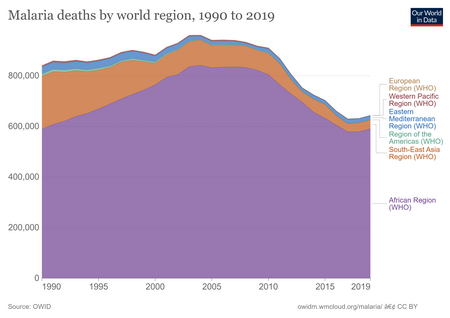Malaria In The Caribbean
 From Mdwiki
From Mdwiki 
Malaria has had a significant impact on the history of the Caribbean, due to its effects on the colonization of the islands and the corresponding impact on society and economy.
Malaria was not found in the Americas prior to the discovery of the New World by Europeans. There was therefore even less immunity among the native populations than there was among Europeans.[2] Due to their genetics, African slaves had greater immunity to falciparum malaria, and this was one reason why slaves were brought in great numbers from Africa.
Creoles felt that diseases such as malaria were tools preventing their territories being invaded by Europeans.[citation needed]
The Caribbean countries most affected by malaria were the Greater Antilles islands and other humid islands like Martinique and Trinidad and Tobago. Anopheles mosquitoes thrive mostly in areas of humidity and fresh water, so the disease was not found on islands such as the Bahamas and Antigua.[citation needed]
As of 2019, several cases of malaria occur each year in Trinidad and Tobago.[3]
See also[edit | edit source]
References[edit | edit source]
- ↑ "Fact sheet about malaria". www.who.int. Archived from the original on 2020-05-02. Retrieved 2024-06-09.
- ↑ Esposito, Elena: “Side effects of immunities: the African slave trade” (2015). European University Institute, Max Weber Programme, Working Paper. [1] Archived 2022-10-28 at the Wayback Machine
- ↑ "Deyalsingh: 5 imported cases of malaria in T&T for 2019". www.looptt.com. Archived from the original on 2019-06-11. Retrieved 2019-06-12.
- McNeill, J. R. (2010-01-11). Mosquito Empires: Ecology and War in the Greater Caribbean, 1620–1914. Cambridge University Press. ISBN 9781139484503. Archived from the original on 2022-04-07. Retrieved 2023-02-17.
- "CARPHA urges region to deal seriously to eradicate mosquitoes". May 14, 2019. Archived from the original on January 26, 2022. Retrieved February 17, 2023.
Categories: [Health in the Caribbean] [Malaria]
↧ Download as ZWI file | Last modified: 06/19/2024 11:35:19 | 7 views
☰ Source: https://mdwiki.org/wiki/Malaria_in_the_Caribbean | License: CC BY-SA 3.0
.svg.png)
 KSF
KSF